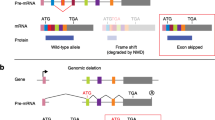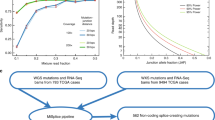Abstract
Hereditary non-polyposis colorectal cancer, an autosomal dominant predisposition to colorectal cancer and other malignancies, is caused by inactivating mutations of DNA mismatch repair genes, mainly MLH1 and MSH2. Missense mutations affect protein structure or function, but may also cause aberrant splicing, if located within splice sites (ss) or cis-acting sequences of splicing regulatory proteins, i.e., exonic splicing enhancers or exonic splicing silencers. Despite significant progress of ss scoring algorithms, the prediction for the impact of mutations on splicing is still unsatisfactory. For this study, we assessed ten ss and nine missense mutations outside ss in MLH1 and MSH2, including eleven newly identified mutations, and experimentally analyzed their effect at the RNA level. We additionally tested and compared the reliability of several web-based programs for the prediction of splicing outcome for these mutations.





Similar content being viewed by others
References
Arnold S, Buchanan DD, Barker M, Jaskowski L, Walsh MD, Birney G, Woods MO, Hopper JL, Jenkins MA, Brown MA, Tavtigian SV, Goldgar DE, Young JP, Spurdle AB (2009) Classifying MLH1 and MSH2 variants using bioinformatic prediction, splicing assays, segregation, and tumor characteristics. Hum Mutat 30:757–770
Asang C, Hauber I, Schaal H (2008) Insights into the selective activation of alternatively used splice acceptors by the human immunodeficiency virus type-1 bidirectional splicing enhancer. Nucleic Acids Res 36:1450–1463
Auclair J, Buisine MP, Navarro C, Ruano E, Montmain G, Desseigne F, Saurin JC, Lasset C, Bonadona V, Giraud S, Puisieux A, Wang Q (2006) Systematic mRNA analysis for the effect of MLH1 and MSH2 missense and silent mutations on aberrant splicing. Hum Mutat 27(2):145–154
Buratti E, Chivers M, Kralovicova J, Romano M, Baralle M, Krainer AR, Vorechovsky I (2007) Aberrant 5′ splice sites in human disease genes: mutation pattern, nucleotide structure and comparison of computational tools that predict their utilization. Nucleic Acids Res 35:4250–4263
Cartegni L, Wang J, Zhu Z, Zhang MQ, Krainer AR (2003) ESEfinder: a web resource to identify exonic splicing enhancers. Nucleic Acids Res 31:3568–3571
Fairbrother WG, Yeh RF, Sharp PA, Burge CB (2002) Predictive identification of exonic splicing enhancers in human genes. Science 297:1007–1013
Freund M, Asang C, Kammler S, Konermann C, Krummheuer J, Hipp M, Meyer I, Gierling W, Theiss S, Preuss T, Schindler D, Kjems J, Schaal H (2003) A novel approach to describe a U1 snRNA binding site. Nucleic Acids Res 31:6963–6975
Goren A, Ram O, Amit M, Keren H, Lev-Maor G, Vig I, Pupko T, Ast G (2006) Comparative analysis identifies exonic splicing regulatory sequences—the complex definition of enhancers and silencers. Mol Cell 22:769–781
Gorlov IP, Gorlova OY, Frazier ML, Amos CI (2003) Missense mutations in hMLH1 and hMSH2 are associated with exonic splicing enhancers. Am J Hum Genet 73:1157–1161
Hartmann L, Theiss S, Niederacher D, Schaal H (2008) Diagnostic of pathogenic splicing mutations: does bioinformatics cover all bases? Front Biosci 13:3252–3272
Kohonen-Corish M, Ross VL, Doe WF, Kool DA, Edkins E, Faragher I, Wijnen J, Kahn PM, Macrae F, St John DJM (1996) RNA-based mutation screening in hereditary nonpolyposis colorectal cancer. Am J Hum Genet 59:818–824
Kralovicova J, Vorechovsky I (2007) Global control of aberrant splice-site activation by auxiliary splicing sequences: evidence for a gradient in exon and intron definition. Nucleic Acids Res 35:6399–6413
Lastella P, Surdo NC, Resta N, Guanti G, Stella A (2006) In silico and in vivo splicing analysis of MLH1 and MSH2 missense mutations shows exon- and tissue-specific effects. BMC Genomics 7:243
Lynch HT, de la Chapelle A (1999) Genetic susceptibility to non-polyposis colorectal cancer. J Med Genet 36:801–818
Madsen PP, Kibak M, Roca X, Sachidanandam R, Krainer AR, Christensen E, Steiner RD, Gibson KM, Corydon TJ, Knudsen I, Wanders RJA, Ruiter JPN, Gregersen N, Storstein-Andresen B (2006) Short/branched-chain acyl-CoA dehydrogenase deficiency due to an IVS + 3A > G mutation that causes exon skipping. Hum Genet 118:680–690
Mangold E, Pagenstecher C, Friedl W, Mathiak M, Buettner R, Engel C, Loeffler M, Hollinski-Feder E, Muller-Koch Y, Keller G, Schackert HK, Krüger S, Goecke T, Moeslein G, Kloor M, Gebert J, Kunstmann E, Schulmann K, Ruschoff J, Propping P (2005) Spectrum and frequencies of mutations in MSH2 and MLH1 identified in 1721 German families suspected of hereditary nonpolyposis colorectal cancer. Int J Cancer 116:692–702
Ohno K, Brengman JM, Felice KJ, Cornblath DR, Engel AG (1999) Congenital end-plate acetylcholinesterase deficiency caused by a nonsense mutation and an A > G splice-donor-site mutation at position +3 of the collagenlike-tail-subunit gene (COLQ): how does G at position +3 result in aberrant splicing? Am J Hum Genet 65:635–644
Pagenstecher C, Wehner M, Friedl W, Rahner N, Aretz S, Friedrichs N, Sengteller M, Henn W, Buettner R, Propping P, Mangold E (2005) Aberrant splicing in MLH1 and MSH2 due to exonic and intronic variants. Hum Genet. doi:10.1007/s00439-005-0107-8
Sahashi K, Masuda A, Matsuura T, Shinmi J, Zhang Z, Takeshima Y, Matsuo M, Sobue G, Ohno K (2007) In vitro and in silico analysis reveals an efficient algorithm to predict the splicing consequences of mutation at the 5′ splice sites. Nucleic Acids Res 35:5995–6003
Shapiro MB, Senapathy P (1987) RNA splice junctions of different classes of eukaryotes: sequence statistics and functional implications in gene expression. Nucleic Acids Res 15:7155–7174
Sharp A, Pichert G, Lucassen A, Eccles D (2004) RNA analysis reveals splicing mutations and loss of expression defects in MLH1 and BRCA1. Hum Mutat 24:272 (Mutation in Brief #738 Online)
Smith PJ, Zhang C, Wang J, Chew SL, Zhang MQ, Krainer AR (2006) An increased specificity score matrix fort he prediction of SF2/ASF-specific exonic splicing enhancers. Hum Mol Genet 15:2490–2508
Tournier I, Vezain M, Martins A, Charbonnier F, Baert-Desurmont S, Olschwang S, Wang Q, Buisine MP, Soret J, Tazi J, Frébourg T, Tosi M (2008) A large fraction on unclassified variants of the mismatch repair genes MLH1 and MSH2 is associated with splicing defects. Hum Mutat 29:1412–1424
Vorechovsky I (2006) Aberrant 3′ splice sites in human disease genes: mutation pattern, nucleotide structure and comparison of computational tools that predict their utilization. Nucleic Acids Res 34:4630–4641
Wang Z, Rolish ME, Yeo G, Tung V, Mawson M, Burge CB (2004) Systematic identification and analysis of exonic splicing silencers. Cell 119:831–845
Wimmer K, Roca X, Beiglböck H, Callens T, Etzler J, Rao AR, Krainer AR, Fonatsch C, Messiaen L (2007) Extensive in silico analysis of NF1 splicing defects uncovers determinants for splicing outcome upon 5′ splice-site disruption. Hum Mutat 28:599–612
Yeo G, Burge CB (2004) Maximum entropy modeling of short sequence motifs with applications to RNA splicing signals. J Comput Biol 11:377–394
Zhang XHF, Chasin LA (2004) Computational definition of sequence motifs governing constitutive exon splicing. Genes Dev 18:1241–1250
Acknowledgments
This work was supported by DFG grant SCHA 909/2-2 (H. Schaal) and by grants from the Stiftung für AIDS-Forschung, Düsseldorf (H. Schaal) and Deutsche Krebshilfe Nr. 1070/2.
Author information
Authors and Affiliations
Corresponding authors
Electronic supplementary material
Below is the link to the electronic supplementary material.
Rights and permissions
About this article
Cite this article
Betz, B., Theiss, S., Aktas, M. et al. Comparative in silico analyses and experimental validation of novel splice site and missense mutations in the genes MLH1 and MSH2 . J Cancer Res Clin Oncol 136, 123–134 (2010). https://doi.org/10.1007/s00432-009-0643-z
Received:
Accepted:
Published:
Issue Date:
DOI: https://doi.org/10.1007/s00432-009-0643-z




